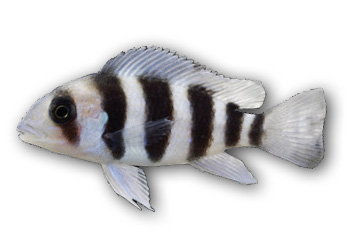Frontosa

Quick Stats
| Size | Males up to 12" (30cm), Females to 10" (25cm) |
|---|---|
| Tank | 180 litres + |
| Swimming Area | Bottom, middle |
| Ph | 7.5 to 9.0 |
| Temperature | 72ºF to 83ºF (23 - 29°C) |
| Food | Pellet, live and frozen foods |
Common Name:
Frontosa.
Distribution:
Africa, Lake Tanganyika.
Colouration:
A beautiful fish, the base color is a bright white. The body is crossed with five or six broad black bands. The fins are a translucent blue to aqua and contrast with the rest of the body. There are variations on the number of bands and fin color depending on the morph and even the individual.
Lifespan:
10 + years.
Maintenance:
10 to 20% weekly. They like to be kept in groups.
Feeding:
In the wild, they eat smaller fishes and some invertebrates, so live foods like Daphnia ssp. water fleas and Artemia ssp. will be especially appreciated, as will feeder fish (quarantined prior to feeding!) and the various "worms" and worms available to the hobbyist. The adults will also take a large range of prepared foods. Freeze-dried shrimp are an especially nutritious and well-received treat for Fronts.
Substrate:
Crushed Coral Sand.
Tank Decor:
Like all true Tanganyikan set ups the tank should be decorated with a crushed coral or similar substrate and contain lot of rocks that form caves and crevices. The rocks must be firmly anchored as these fish will dig a lot and can disrupt the aquascape and possibly hurt themselves or the aquarium. Plants can be used and will not be eaten but should be placed carefully as their digging will continually uproot them.
Filtration:
Good filtration as it can be a messy fish, especially when fed live food.
Biotype:
Rocky waters with sandy bottoms starting at depths of approximately 30 feet.
Breeding:
A mouthbrooder the Frontosa is a little more selective than most and the ratio of three to one is needed to form a proper pair. The next step is the selection of the spawning site. A smooth rock lying on the bottom or even a bit of rockwork showing through the sand will be chosen and the pair will begin to clear away as much sand as possible from the area and excavate a spawning pit or shelf upon which to place their spawn. The female will place a few eggs in the pit and the male will follow and fertilize them. This will continue until the female picks up the eggs in her mouth and starts the incubation period. The mother will incubate the eggs for about a month and then the young will emerge. They are fairly large in size (about .5")and can be fed newly hatched frozen or live brine shrimp. The mother will guard the fry for a period. Females don't grow as large as males and won't grow the large nuchal hump of the latter (but may grow a nuchal hump of some size).